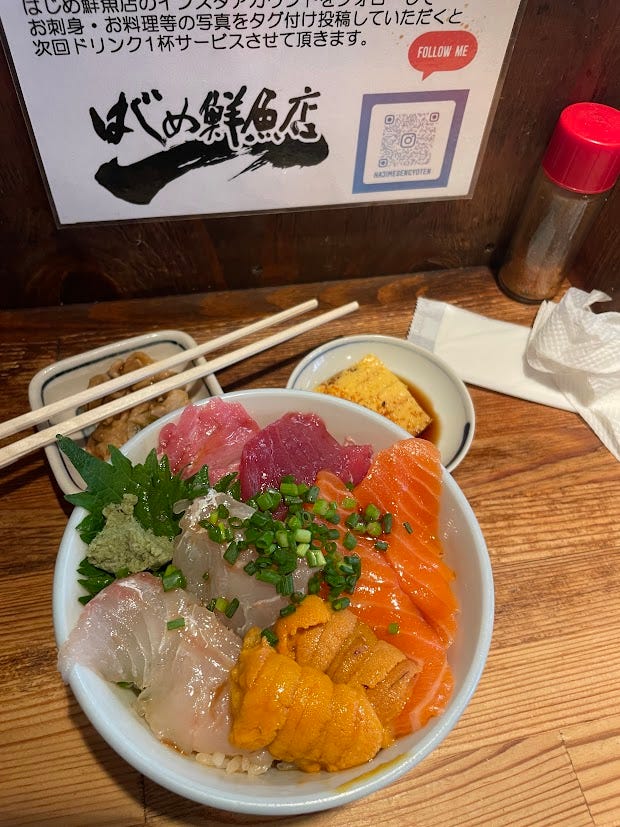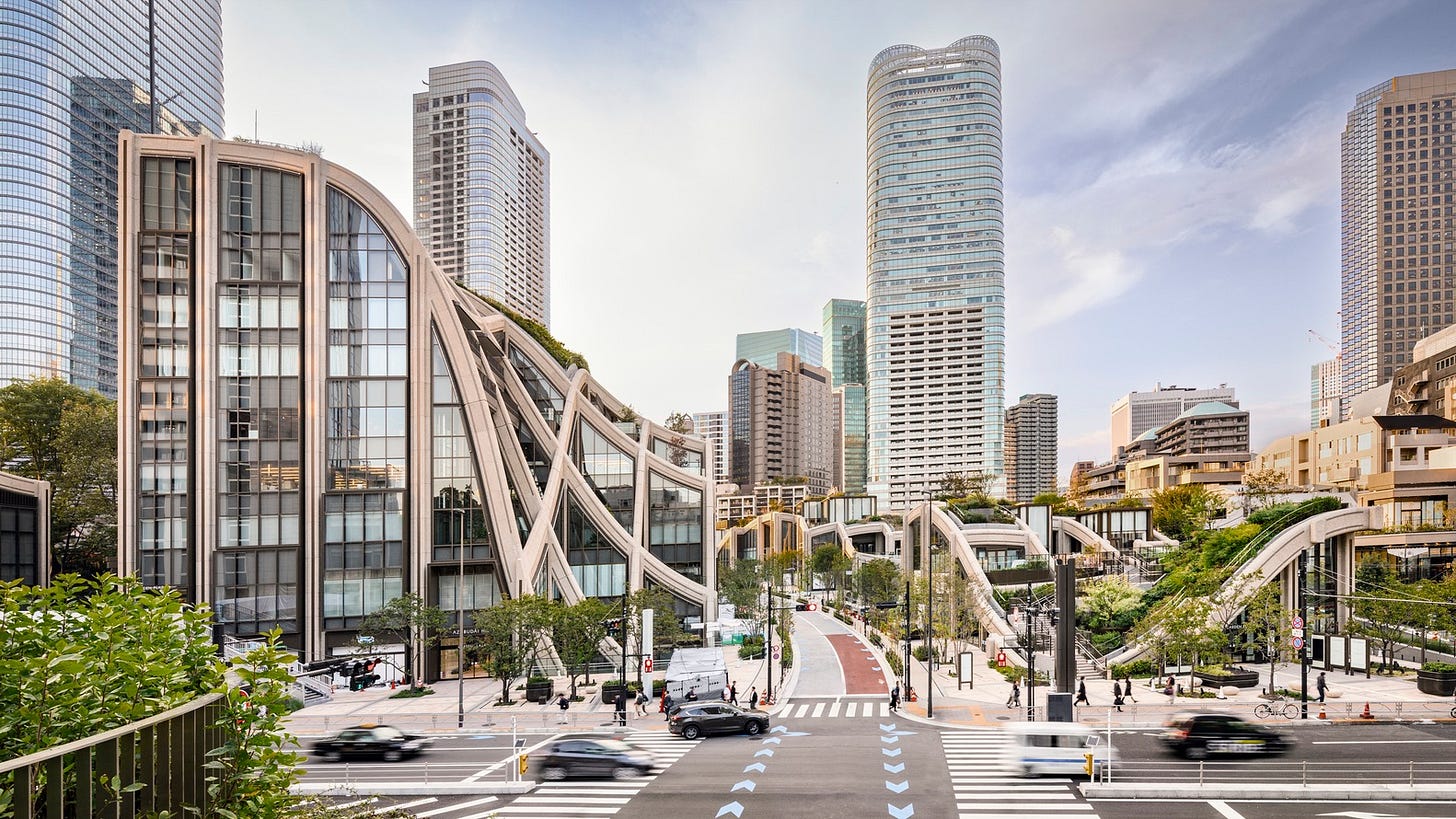Four months after leaving Tokyo, stomach full of sashimi and empty of regrets, I found myself in Haneda airport again.
Middle school classmate: Not to sound stalkerish, but weren’t you just in Japan a few months ago?
Me: Haha… yeah, I’m back.
A weak yen + middle school nostalgia for Japanese knick-knacks and entertainment + aspiring cultural foodie with disposable income = Japan trip.Everyone and their mother is in Japan this summer. We’ve turned the corner around European romanticism and headed toward Asia era. I flip through Instagram stories of the frenetic Shibuya crossing and Shinjuku’s neon billboards, relieved that this time around, I can avoid the tourist throngs.
This time, I traveled solo with a far less Instagrammable itinerary. I grabbed lunch at local seafood joints with Japanese salarymen, lounged around in an air-conditioned barber shop as my friends secured a fresh trim, and ran on the treadmill at the public sports center to duck from the torrential downpour. The few picturesque moments were for my own eyes to savor, no one else to capture me in the moment.
To call it “living the slow life” would be a stretch, but certainly this trip has been characterized by glimpses into the local lifestyle. While biking around Yoyogi Park, my memory cascaded to a childhood companion: the green-haired Yotsuba from my first manga, Yotsuba&! This series formed my first impression of Japan, way before all the magical worlds of Pokémon, Nintendo, and Alice in Borderland.


Yotsuba&! is a slice of life manga, depicting the mundane daily lives of its characters. Yotsuba spends summers riding her bicycle and catching cicadas. There is no major plot, just short scenes of her hanging out with her adoptive father and neighbors.
Everyone: What did you do in Tokyo?
Me: Not much… I just hung out with friends.
We lounged around in K’s flat while the sun began to set behind the dainty, serene streets of Kagurazaka, Tokyo’s “Little Paris.” Although the window was open, we played in our own bubble—clothes and trash were strewn across the floor; Justin Bieber and Central Cee boomed on the speakers.
K: Sometimes, I have the urge to blast music out to the streets.
S: Same, but I don’t want to ruin the peace.”
In Japan, there’s the urge to not disrupt the preexisting ambience. I usually jaywalk and sometimes litter (don’t pretend you don’t), but here, I mostly (albeit impatiently) wait for the crosswalk light to turn green and stash my trash in my pocket until I find the nearest trashcan.
“The streets are so clean, and everyone is so polite,” is a common first observation about Tokyo. Indeed, it is a very livable city, but to live in it is a different question. It feels foreign—or rather, I feel foreign in it.
Lost in translation
Permeating the calm yokocho alleyways at daylight is a sense of complacency. Perhaps others would describe it as comfort. A year ago, K expressed his fears of moving back to Tokyo, where people are more introverted and less open-minded. Now, he’s found comfort at his own pace—grinding on the weekdays, Friday and/or Saturday nights out, then onsen and massage on the weekend.
It’s living the more mundane life with K and his friends that I begin to see the nuances of this city. In February, I’d shivered with high thrills while dancing at TK nightclub in Shibuya, slurping down sashimi in Tsukiji, and petting capybaras in a cafe. However, this time I was more than just a tourist; I was a woman and a foreigner.
Strolling through Kagurazaka, I peered at the zakkyo buildings through a different lens, now knowing that they emerged from the neighborhood’s Edo legacy as a geisha district. After the prohibition of most geisha houses in 1948, they converted into luxurious traditional Japanese restaurants known as ryotei that are scattered around Kagurazaka’s unassuming alleyways.1

I have nothing against geisha, but in general, the objectification and sexualization of Japanese women seem to pervade the urban metropolis. For instance, women-only seats and carriages on Tokyo’s subways and trains take into effect during morning rush hour. How considerate, I thought, until I realized their existence alludes to the prevalence of sexual harassment, such as groping and pedophiles taking photos up the skirts of schoolgirls.
During meals with my Japanese friends, I stared slack-jawed as they bantered rapid-fire in their native language, faces contorted into expressions I’d never before witnessed.
“You’ve been in Japan for three weeks and haven’t learned the language. It’s disrespectful,” K chided.
I know he’s joking, but it’s true. Sometimes, I try. But then, arigatōgozaimasu stumbles crookedly from my lips, and my gaze falls to my feet. When a large part of my self-worth comes from my ability to communicate and speak, being lost in translation breeds a bone-shaking loneliness.
No one enjoys a language barrier, I imagine, but it feels like particularly disquieting experience for me, someone who stakes their identity in language. Isn’t it embarrassing and disorienting to dedicate a life towards communication, studying the written word, only to discover the uselessness of all that work in another country? What good are the hours poring over text, clicking and clacking away at a keyboard in the face of another language?
“What Travel Does” by Nikhil
These inescapable qualms kept my mood at a steady flatline. There were no particular highs or lows; nothing exciting or mind-blowingly new (aside from my first strawberry smoothie at 7-Eleven). The entire time, I felt mildly content, like sucking on a stale lollipop rather than biting into a piece of rich dark chocolate.
You dream in a language that I can't understand. It's like there's this whole place inside of you where I can't go.
—Past Lives (2023)
My stomach dropped at the realization that I could never truly understand the syllables uttered by my friends. There is an entire side to them I can only be a passive witness to. Yet, just seeing the way TK’s neck veins constricted in laughter and hearing K’s deep chuckle that comes out once in a blue moon, my heart stayed afloat. Emotions, music, food, and dance transcend language. They’d welcomed me into a version of themselves they’d left across the Pacific Ocean, and for that gesture, I have endless gratitude.






Finding my next bite
By now, I’ve started to establish my own system for finding my next bite. Although the dollar is strong, given the hefty price tag on flights ($1600+), I’m not willing to drop hundreds on a singular meal.
At the moment, I’m loving handwritten Japanese menus with a limited selection of local delicacies, served at the counter before the chef(s). The primary target customer should be locals who are enticed enough to become regulars: Japanese salarymen headed to an izakaya after work to let the stress out over Kirin. Precision and mastery are necessary for this kind of craft. After all, the meal is not a product, but an experience prepared before the eyes and tastes of the all-in-one guest, judge, and patron.


Here’s my list of places that fit these criterion. A big shoutout to Shunsai Miyazaki in Shinjuku for serving my favorite meal: a three-course dinner of obanzai, sashimi, and fish for 2500 yen. While eating at the counter, I talked to the chef, a mutual friend’s brother-in-law, via Google Translate.



Underrated Tokyo favorites
Azabudai Hills: a large-scale multi-use urban development project, featuring a mix of residential, commercial, and cultural facilities, including luxury brands, an extensive food market, and a teamLab art museum.
Daikanyama: a trendy, upscale neighborhood known for its boutique shopping, stylish brunch and dessert cafes, and laid-back, sophisticated atmosphere. It includes many multi-use complexes such as Hillside Terrace and Forestgate.



Shimokitazawa: a bohemian neighborhood renowned for its indie music scene, vintage clothing stores, and eclectic mix of cafes and bars. My favorite place is Reload, an open-layout shopping mall with a curated selection of independent boutiques, artisanal shops, and trendy cafes.



Next up: bullet train journeys to Kyoto, Osaka, and Karuizawa!
Indeed, the neighborhood boasts 23 Michelin Guide-Listed restaurants!







thanks for quoting me! jealous of all the time you get to spend in japan — enjoy it!